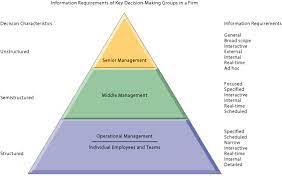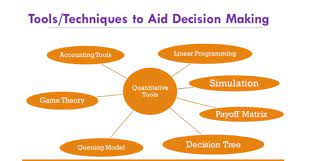Decision Making Model in Management
Decision making is a crucial aspect of management that can greatly impact the success of an organization. A decision making model provides a structured approach to making decisions, helping managers analyze situations, evaluate alternatives, and choose the best course of action.
One commonly used decision making model in management is the Rational Decision Making Model. This model involves a systematic, step-by-step process that includes:
- Identifying the problem or opportunity.
- Generating alternative solutions.
- Evaluating and comparing alternatives based on criteria.
- Selecting the best alternative.
- Implementing the decision.
- Evaluating the outcome and adjusting as needed.
Another popular model is the Bounded Rationality Model, which acknowledges that managers may not have access to all information and must make decisions based on limited resources and time constraints. This model emphasizes satisficing – choosing a solution that meets minimum requirements rather than seeking the optimal solution.
In addition to these models, there are other decision making approaches such as Intuitive Decision Making, Behavioral Decision Theory, and Group Decision Making. Each model has its own strengths and weaknesses, and managers must choose the most appropriate one based on the specific situation they are facing.
Effective decision making in management requires critical thinking, analytical skills, creativity, and collaboration. By using a decision making model as a guide, managers can make well-informed decisions that lead to positive outcomes for their organizations.
7 Essential Tips for Effective Decision Making in Management
- Clearly define the decision to be made.
- Gather relevant information and data before making a decision.
- Consider the potential outcomes and consequences of each option.
- Involve key stakeholders or team members in the decision-making process.
- Evaluate the risks associated with each alternative.
- Choose a decision-making model that best fits the situation (e.g., rational, intuitive, collaborative).
- Implement the chosen decision effectively and monitor its impact for future adjustments.
Clearly define the decision to be made.
In the realm of management decision making models, a crucial tip is to clearly define the decision to be made. By establishing a precise understanding of the problem or opportunity at hand, managers can effectively navigate the decision-making process with clarity and purpose. This initial step sets the foundation for identifying key objectives, generating relevant alternatives, and ultimately selecting the best course of action. Clear definition not only streamlines the decision-making process but also ensures that all stakeholders are aligned and focused on achieving a common goal.
Gather relevant information and data before making a decision.
Gathering relevant information and data before making a decision is a crucial tip in the decision-making model in management. By collecting and analyzing pertinent information, managers can ensure that their decisions are well-informed and based on facts rather than assumptions. This step helps in evaluating alternatives more effectively, identifying potential risks, and predicting outcomes with greater accuracy. Ultimately, thorough information gathering leads to more confident and successful decision-making processes in management.
Consider the potential outcomes and consequences of each option.
When utilizing a decision making model in management, it is essential to consider the potential outcomes and consequences of each option. By thoroughly evaluating the possible results of each alternative, managers can make more informed decisions that take into account both short-term and long-term implications. This step helps in assessing risks, benefits, and impacts on various stakeholders, ultimately leading to a more strategic and well-thought-out decision-making process.
Involve key stakeholders or team members in the decision-making process.
In the realm of decision making models in management, a valuable tip is to involve key stakeholders or team members in the decision-making process. By engaging individuals who are directly impacted by the decision or who possess relevant expertise, managers can gain valuable insights, perspectives, and buy-in. Involving key stakeholders fosters collaboration, enhances the quality of decision-making outcomes, and promotes a sense of ownership and commitment among team members. This inclusive approach not only leads to more informed decisions but also strengthens relationships and builds a culture of trust and transparency within the organization.
Evaluate the risks associated with each alternative.
When utilizing a decision making model in management, it is essential to evaluate the risks associated with each alternative. By carefully assessing the potential risks and uncertainties of each option, managers can make informed decisions that consider both the potential benefits and drawbacks. Understanding and analyzing the risks involved allows managers to mitigate potential negative consequences and choose the alternative that offers the best balance of risk and reward for the organization.
Choose a decision-making model that best fits the situation (e.g., rational, intuitive, collaborative).
When it comes to decision making in management, it is essential to choose a decision-making model that best fits the situation at hand. Whether it is a rational, intuitive, or collaborative approach, selecting the most appropriate model can greatly impact the outcome of a decision. The rational decision-making model may be suitable for situations where a systematic analysis of alternatives is needed, while an intuitive approach might be more effective in instances where quick decisions based on gut feelings are required. Collaborative decision making can be beneficial when involving multiple stakeholders in the decision-making process. By carefully considering the specific circumstances and choosing the right decision-making model, managers can make well-informed decisions that align with their organizational goals and objectives.
Implement the chosen decision effectively and monitor its impact for future adjustments.
Implementing the chosen decision effectively and monitoring its impact for future adjustments is a crucial step in the decision making process in management. Once a decision has been made, it is important to ensure that it is executed properly to achieve the desired outcomes. By closely monitoring the impact of the decision, managers can evaluate its effectiveness and make any necessary adjustments to improve future decisions. This proactive approach allows organizations to learn from past decisions and continuously improve their decision making processes for long-term success.



